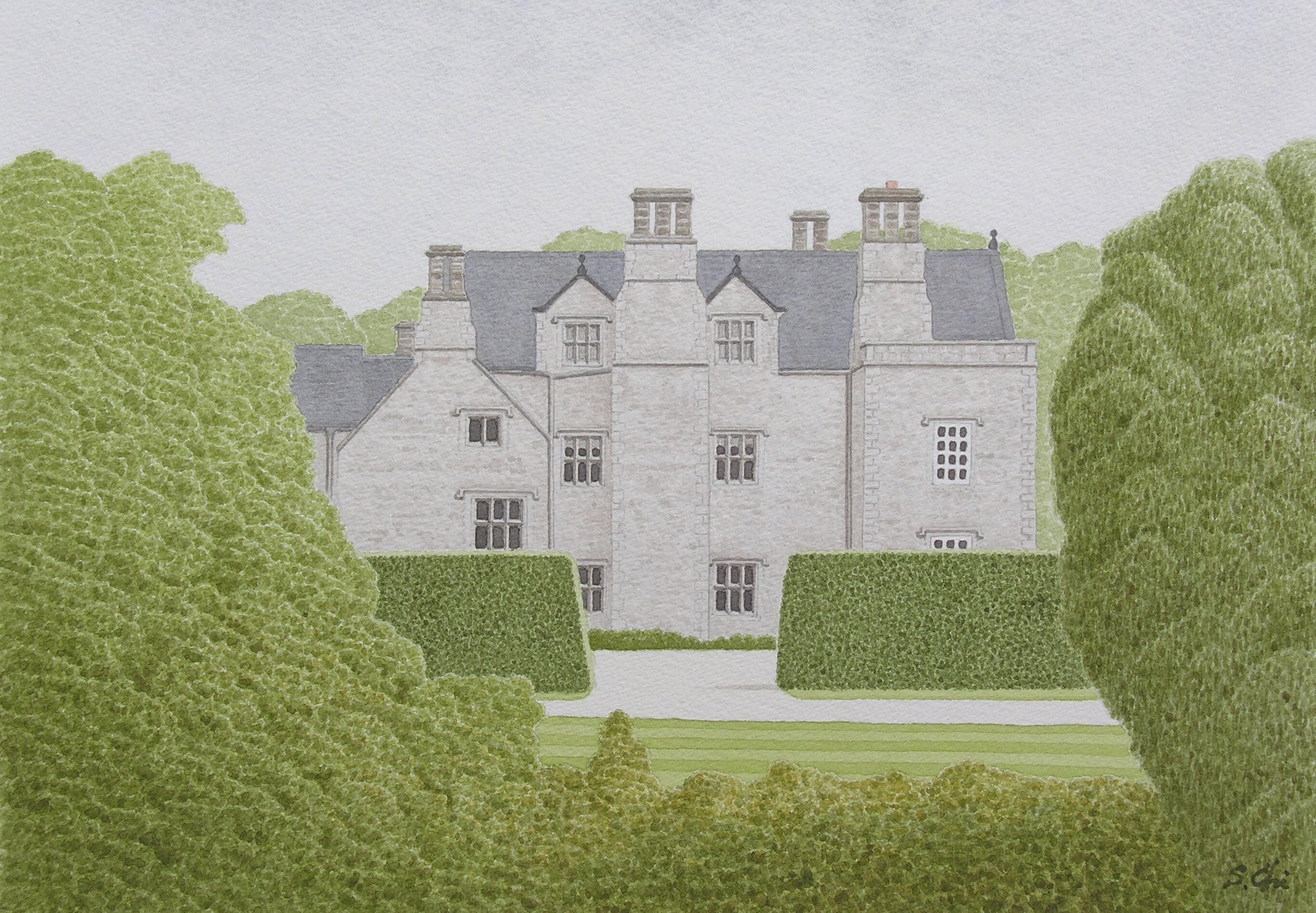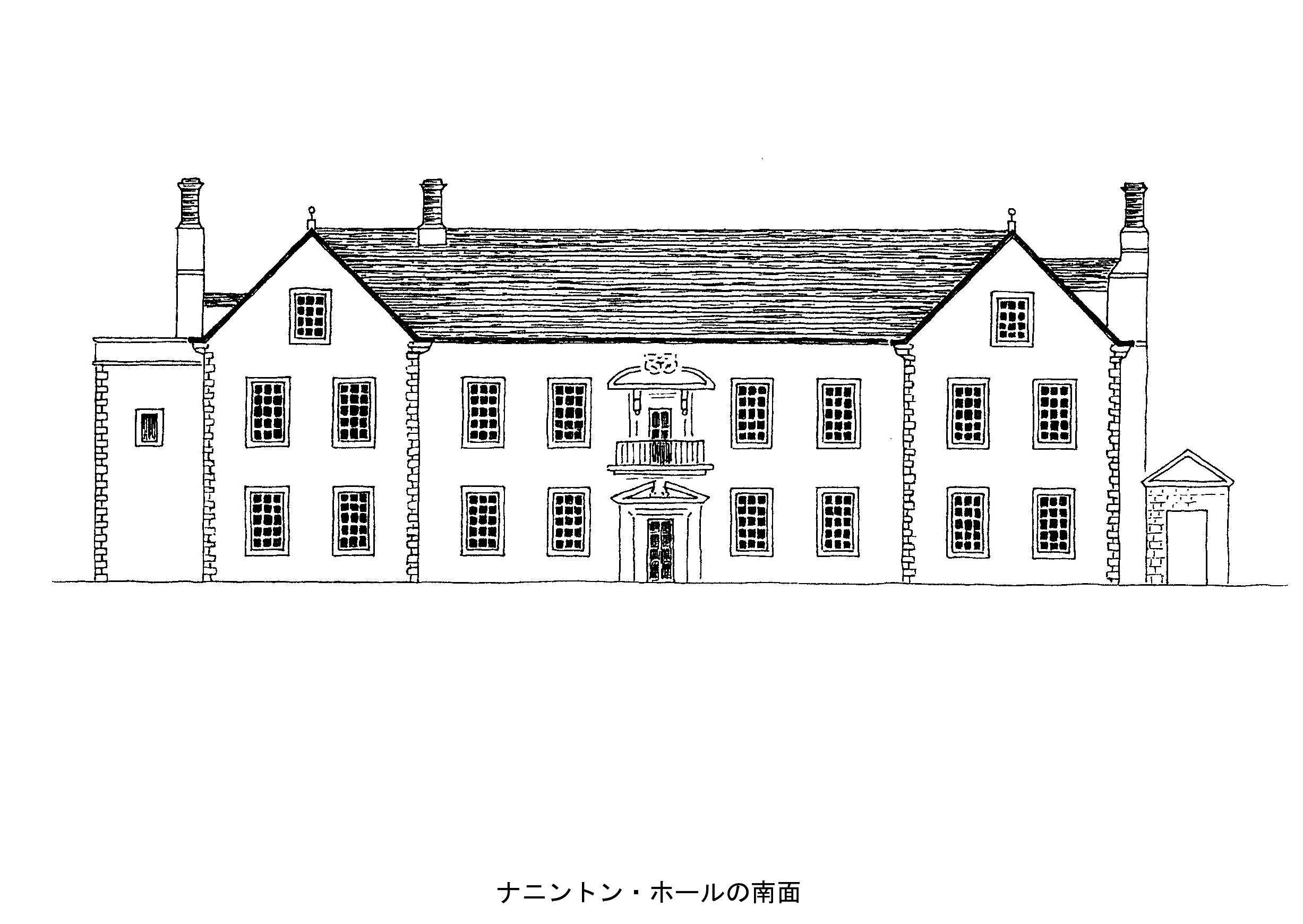
遥かなる わがヨークシャー (Faraway My Yorkshire)
ノース・ヨーク・ムーアズ (The North York Moors)
77 ナニントン・ホール [ヘルムズリー近く] (Nunnington Hall, near Helmsley)

ヘルムズリー城から南東へ8kmほど行ったところ、ヨークからでは北へおよそ30kmのところのライ川のほとりに、ナニントン・ホールというマナー・ハウスがある。
ここのマナー(荘園)の歴史は非常に古く、その起源は、5世紀にイングランドに侵入してきたアングロ・サクソン人の定住地にあるという。ノルマン征服の前には、サクソン貴族のマナー・ハウスがあったとされている。
いまあるナニントン・ホールは、16世紀のなかごろに創建されたもの。それ以来、17世紀の末まで何度も改造がくりかえされてきたが、東西の翼棟には、エリザベス朝からステュアート王朝にかけての様式が残されている。
入口のある西翼棟で、それらの特徴である「マリオンとトランサムの窓」、「ドーマー・ウィンドウ(屋根窓)」、そして巨大な「チムニー・スタック*(組み煙突)」が見られる。なかでもチムニースタックは印象的で、このマナー・ハウスを特徴づけているものの一つである。
館(やかた)の南側は西側とはまったくことなり、17世紀後半の後期ステュアート王朝の特徴を見せている。サッシ・ウィンドウ(上げ下げ窓)が整然とならび、簡素で端正な雰囲気が感じられるのである。
このマナー・ハウスの特徴の一つに、オーク材で内装されたグレート・ホール(大広間)がある。ここではその名も「オーク・ホール」と呼ばれているが、壁一面がオーク材の羽目板張りであり、2階につづく大階段もオーク材でできている。
部屋の中央には、天板の厚さが10cmくらいで、幅が1mくらい、長さが6、7mもあろうかというような、大きなどっしりとしたテーブルが置かれている。これもオーク材である。天板の表面には、オーク材の力強い木目が、レリーフのように浮かび上がっている。内装といい家具といい、簡素でがっしりとした造りで、いかにも質実剛健のイギリスらしさを感じさせるものがある。
それにしても、マナーハウスでオーク材を多用した内装や家具を見ていると、イギリス人がいかにこの木を尊び、愛し、大事にしているかがよくわかる。
このマナー・ハウスも、英国史に登場してくる人物と関係のあった、興味深いところである。
まずこのマナー・ハウスは、ヘンリー8世の6度目の王妃となったキャサリン・パーの母親マティルダ・グレンが生まれたところとして知られている。
キャサリンの兄弟に、ナニントン・ホールを相続したウィリアム・パーがいる。彼はキャサリンの余慶でノーサンプトン侯爵となったが、1553年にあった「九日間女王ジェイン・グレイ*」の事件にかかわった疑いで称号を失い、ナニントン・ホールをふくむ全財産を王室に没収された。
ナニントン・ホールはその後、長いあいだ王室のものとして賃貸に出されていた。エリザベス1世の時代の1567年には、彼女の侍医であったロバート・ヒュイケスに貸し出された。
G.M.トレヴェリアンの『イギリス史』によると、エリザベス1世は、自分が子供を産めない体であることを知っていて、それをだれにも、側近中の側近であったサー・ウィリアム・セシル(のちのバーリー卿)にさえ明かさなかったという。
ナニントン・ホールのガイド・ブックを読んでおどろいたことに、「エリザベスには子供が望めない」ということが分かり、それを彼女に告げたのが、侍医のロバート・ヒュイケスだった――というのである。
それを告げられたときのエリザベスの心のうちは、いかばかりであっただろうか。彼女は「イングランドと結婚した」と宣言して結婚を考えなかった。その背景にはほかの理由もあったかもしれないが、このことも大きな要因の一つであっただろう。
ナニントン・ホールは、1644年のヘルムズリー城の包囲戦のとき、議会軍に接収されて兵士たちの宿泊所として使われた。そのため戦いが終わって軍隊が去ったときには、廃墟のように荒れていたという。
ジェイムズ2世(在位1685-88)の時代には、枢密院長をつとめた初代プレストン子爵リチャード・グレイアムの館になったこともあった。館を後期ステュアート王朝に改造したのは、彼である。
プレストン卿は、名誉革命でジェイムズ2世が1688年の末にフランスへと逃れたあとも国内にとどまり、王の復帰のために活動していた5人の有力貴族のひとりであった。しかし、その活動が発覚して彼は逮捕され、反逆罪で処刑されるところだった。
それを救ったのは、彼の末娘でまだ幼かったスザンナだったという。彼女は女王メアリー2世に父の助命を直訴し、それに心を動かされた女王が、夫で共同統治の王であったウィリアム3世にプレストン卿の赦免を説得したのである。
1691年にロンドン塔から釈放されたプレストン卿は、政界を引退するとナニントン・ホールに戻り、亡くなるまでの数年間を静かに暮らしたという。
いまナニントン・ホールは、ナショナル・トラストによって保存・管理されている。

Nunnington Hall is on the River Rye, 5 miles to the southwest of Helmsley
Castle and 19 miles to the north of York. The history of this manor is
very old. It is said that there was a homestead of the first Anglo-Saxon
settlers in this site.
The manor house we can see today was built in the middle of the 16th century.
Since then, as the house was remodelled and repaired repeatedly, the architectural
style is complicated. We can see the features of Tudor and late Stuart:
the exteriors of wings are the former and the interiors and the south front
of the house are the latter.
The most impressive part in this house is the huge chimney stack of the
west wing which has features of the Elizabethan and the early Stuart periods.
It attracted my attention when I first saw this house. This chimney stack
is one of the symbols of Nunnington Hall.
The south front, having the late 17th century's features of the late Stuart
with sash windows, is very different from the west. The south shows the
simple and neat mood.
Other features of this manor house, which impressed me very much, are panelling,
staircases and furniture of the great hall which was called "Oak Hall"
here. They, made of oak, seemed to me the good examples of Englishness:
simple and sturdy. I could also understand well how English people place
a high value on oak and love it.
One of the pleasures for me of visiting manor houses is to know the other
or hidden side of English history. I am very much interested in this Nunnington
Hall, since it is associated with many characters appearing in the English
history.
This manor house is known as the house where Mathilda Grene was born. She
was the mother of Catherine Parr, Henry VIII's sixth and the last wife.
The manor house was inherited by Catherine's brother William Parr, Marquess
of Northampton. He lost his title and all property, including Nunnington
Hall, in the affairs of "Nine-day Queen, Lady Jane Grey" because
of his suspicion of involving himself in the conspiracies.
Reading "History of England" by G.M.Trevelyan, I was surprised
and impressed to learn that Elizabeth I knew she was incapable of child
bearing. She kept it secret even from Sir William Cecil, one of the most
trustworthy her brains.
Visiting Nunnington Hall, I was surprised again to learn that Robert Huickes,
a "Doctor of Physique" to Henry VIII, Catherine Parr, Edward
VI and Elizabeth I, leased the Hall in 1567. He was the very doctor who
knew that Elizabeth could never have children and told it to her. I think
the fact wopuld make her an iron lady and let her decide to marry none,
declaring instead to marry England. Thinking of her reaction to the words
of Dr Huickesa, I cannot but sympathize with her deeply and respect her
as one of the greatest sovereigns.
While the siege of Helmsley Castle in 1644, Nunnington Hall was commandeered
by the Pariamentary army and used for billeting troops. When the soldierts
left the hall after the siege, it had been ruinous and defaced. The hall
was left derelict.
In 1685, Richard Graham, 1st Viscount of Preston and Lord President of
the Council of James II, owned Nunnington Hall and restored it. He also
modernised its south front and the inside of the house with the late Stuart
style.
When James II left England in 1688, Lord Preston was one of the five leading peers stayed behind, who were entrusted with the restoration of James. But the Lord was arrested by the new regime for manoeuvring the return of James to England. It was his youngest daughter Susannah who saved his life, pleading with Queen Mary II for mercy. Lord Preston is said to have spent the rest of his quietly at Nunnington.
*チムニー・スタック (chimney stack)
各階の暖炉からの煙突を一つにまとめた大煙突のこと
*ジェイン・グレイ,九日間女王 (Nine days Queen, Jane Grey)
1553年、プロテスタントのエドワード6世が他界したあと、メアリー1世が即位するまでのあいだ、9日間だけ在位した女王。カトリックのメアリーが即位することを嫌ったノーサンバランド公ジョン・ダドリー
(John Dudley, Duke of Northumberland)の陰謀で、意に反して女王の座に据えられた。この陰謀は公の強引なやり方が諸侯や国民の反発を招いて失敗し、結局はメアリーが即位することになった。ジェインはカトリックへ改宗すれば罪は問わないとされたが、それを拒みつづけたため1554年にロンドン塔で斬首刑になった。宮廷の権力闘争に巻き込まれて16歳で生涯を終え、英国史でも省略されることがある悲劇の女王。